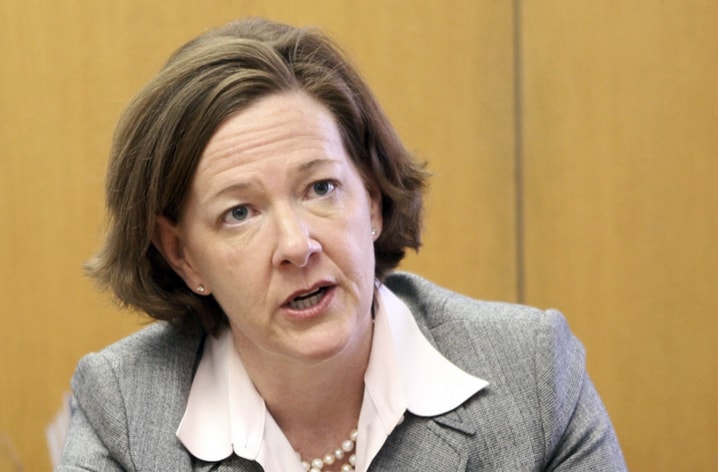Alberta Premier Alison Redford vows she’s the right leader to bring about fresh, positive changes if voters give her the chance in an election she says will define the future for Alberta.
Meeting with the Red Deer Advocate editorial board on Friday, the Progressive Conservative leader appealed to the 60 per cent of eligible voters who didn’t cast ballots in the 2008 election. The April 23 election does matter, said Redford who only six months ago won the party’s leadership race.
“People are very focused that this is an election that will define the future,” said Redford. “This is a level of engagement that we didn’t see in the 2008 election. We know now more than we did then that we have an economy that really is the envy of North America.”
Although the Progressive Conservatives has been in power 41 years, Redford said she believes her party has the ability to still make positive differences in the lives of regular Albertans.
“I’m all about change,” said Redford.
During her 45-minute meeting with the editorial board, Redford said she remains committed to investing in municipal infrastructure, creating local involvement in health care decisions and improving education at the primary, secondary and post-secondary levels.
“We will be planning ahead for 20 or 30 years with respect to infrastructure and social policy.”
Redford said her party will continue to put money into the Municipal Sustainability Initiative, which since 2007 has been providing funding for municipal infrastructure projects.
“We talk often in Alberta how our per capita spending on infrastructure is three times as high as in some other provinces, but the reason is we have such a big province and we’re trying to keep communities growing.”
Redford said that recreational and cultural projects are important, including the proposed $89-million multi-use aquatics centre being sought by a number of aquatics groups in Red Deer. The Central Alberta Aquatics Centre is seeking provincial dollars because the city says it won’t have the resources to fund such a project for many years.
Projects like this can be funded through the MSI, Redford added.
“When you look at the Municipality Sustainability Initiative, it gives local governments the opportunity to make those kinds of choices,” said Redford. “Every community will have a different perspective on what they think their priority should be and we don’t want to step in the middle of that.”
City of Red Deer officials have expressed disappointment over the largest education property tax increase in 20 years. The province is increasing its education tax portion by $107 million over 2011.
Redford replied the education portion of the tax is what the province has control over, and this year, the education property tax rate was frozen.
“The reason people are going to see an increase on their education property tax isn’t because of a rate increase but because the value of property has gone up,” she said. “From our perspective, we’ve been completely neutral on this.”
Redford said she’s aware some municipalities are lacking essential infrastructure, such as in Blackfalds where roughly 600 children, or about half of the school-aged population, are being bused because they don’t have a school to go to.
The provincial government is starting to deal with these issues more quickly, Redford said.
“We have included in this year’s capital budget for more schools,” she said. “We’ve got to be investing in that infrastructure and we have the ability to do it.”
Redford said they’re not just responding to needs, but getting ahead of them.
She’d like to see schools built in the future where they have multi-uses as well. Facilities have to be built differently, she said.
When asked about Red Deer College and whether it could get university status, Redford said she agrees that more programs need to be delivered there.
“I don’t think you could have too many universities. If Red Deer College is aspiring to be a university, then we need to do our best to support that.”
Redford said she will continue to support keeping the government-appointed Alberta Health Services super health board instead of reintroducing elected regional boards.
People outside and within the healthcare system do not want to see the system change again because they need that certainty to address the problems, Redford said.
However, she said she recognized communities haven’t been able to offer much meaningful impact into the decision-making process.
The province has started putting in place community committees, which will work with the minister of Alberta Health and Wellness. That way, long-term sustainable health care plans can be created and then implemented by Alberta Health Services, Redford said.
Redford said she believes in listening to the people and has heard the outcries of Sylvan Lake residents who want traffic lights at the intersection of Hwy 781 and Hwy 11.
“I’m aware of the issue and it’s been brought to my attention a couple of times,” said Redford. “There’s a whole system in place around decision-making in infrastructure and transportation that needs to be shifted.”
She said she doesn’t believe the discussion has ended between the province and the community.
“We need to make sure that the decisions that are made make sense for the businesses and safety on the road. It will always take time to make these kind of decisions. And my approach is to listen everyone as part of this and we’re going to do that.”
ltester@www.reddeeradvocate.com
